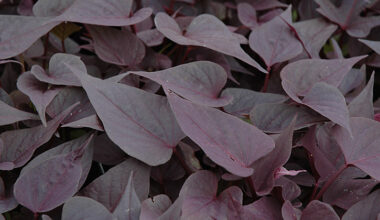Colocasias are also called “elephant ears” for their huge leaves, or “cabbage” and “taro”. This perennial herb with an exotic appearance belongs to the Araceae family (Araceae), like the arums. It is an elegant and generous ornamental plant native to humid tropical regions, which likes water, light and half-shade. We explain how to multiply it by dividing the tubers.
Contents
Propagating the elephant ear plant
Although it is possible to sow it, colocasia multiplies primarily by dividing tubers or by sampling rejects emitted by runners. This will allow you to regenerate your plants.
Division of tubers or rhizomes
The division prevents the clumps from becoming too dense, while regenerating your plants, and will allow you to install it in another part of the garden. Elephant ear plant sometimes produces small tubers alongside the main tuber. You just have to separate them. This should be done at the end of winter, around the month of March.
- Gently dig the colocasia out by digging around it if it is in the ground, or take it out of its pot.
- Remove part of the substrate to make the tubers clearly visible. You can pass them under water if necessary.
- Divide by separating the tubers.
- Replant them in pots filled with potting soil and water.
Stolon Marcottage
Like strawberries, Elephant ear plant sometimes emits long runners that run on the soil surface. These are horizontal stems that give rise to new tufts. You can therefore easily separate them from the original plant and then replant the young shoots in a pot or in a new location.
If you see these horizontal stems appear, cover them with a little soil to allow them to root and develop a new seedling. Once it has several leaves, you can separate it from the mother plant by cutting the runner that connects them. Replant in a pot and water.
How to perform a tuber division on the elephant ear plant
The division of bulbous plants is sometimes done naturally, but a little help may be necessary. The division is a mode of vegetative propagation of bulbous plants and perennials in general, which consists in dividing the underground part of the plant into several pieces.
This makes it possible, on the one hand, to quickly obtain new seedlings from a single plant and, on the other hand, to rejuvenate an old plant which has become too dense and in loss of vigour.
Proceed at the end of winter
A tuber (anemones, tuberous begonias, cyclamens…) is a portion of underground stem, more or less rounded in shape, swollen by the plant’s reserves and bearing dormant buds. The latter will give birth to new aerial stems.
A tuberous root (dahlias, peonies …) is a root that stores nutrient reserves. It emits buds (generally at the collar) which allow the vegetative reproduction of the plant.
The division of tuberous plants is most often practiced at the end of winter, when the buds begin to develop into young shoots.
Keep a bud on each piece
The method is simple and the recovery rate is relatively high. Using a sharp knife, divide the stump into several pieces. It is important to make clean cuts.
Each piece must have a viable sprout or bud to ensure recovery.
If, during division, some tubers or large roots are cut in half, don’t panic! This does not jeopardize the recovery, as long as they are not cut at the collar.
Rejuvenate and multiply
You then get new seedlings. Sprinkle charcoal powder or an antifungal agent on the exposed parts to limit the risk of rotting or fungal diseases.
Then put them in a pot or in the ground, first in a sheltered place as long as the risk of frost is not excluded. Water regularly and without excess. Then plant outdoors in the ground or take the pots outdoors when you have noticed the recovery.
Rhizome Division on the Elephant ear plant
What is a rhizome?
Rhizomes (iris, eagle fern, lily of the valley, seal of Solomon…) are underground stems that develop horizontally, and produce aerial stems.
They are inflated by the food reserves they store.
The division of rhizomes is often necessary to aerate and breathe new life into dense clumps.
Locate peripheral shoots
After digging out the clump with the spade fork, taking care not to damage the roots, shake it gently to make the soil fall off.
Locate the youngest rhizomes located on the periphery of the clump and remove them. Cut them into sections. Each section should have leaves or at least one leaf start. The cut is made at the base of the leaves, in the narrow zone between two feet.
Ensure the recovery of new plants
The already formed leaves are cut in half and then the sections are put in the ground. The roots should be lightly buried but the section should be at ground level.
The central part of the stump corresponds to the oldest part of the plant. This part is often less vigorous and no longer produces flowers. It is thus often not interesting to preserve it.
Summary
Colocasia is a plant that produces shoots, they are the ones that will be separated from the main shrub. These rejections appear thanks to the stollons which allow the plant to multiply naturally and easily.
Propagation is also carried out by sowing, in a warm place, but it is much easier to make a division on the tubers in the spring.









